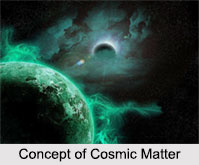 Concept of Cosmic Matter refers to all that matter which does not have consciousness, mainly material objects. Prakriti is the most original cosmic matter which includes within itself the various evolutes of the material universe. There are three real and distinct ontological entities which have been admitted by the Vishishtadvaita Vedanta on the basis of the teachings of the Upanishads. These are - Ishwar (God), cit (soul) and acit (cosmic matter). These have provided the basis for the theological doctrines of Vaishnavism. As regards cosmic matter, the word acit means that which does not have consciousness as compared with cit, which possesses knowledge.
Concept of Cosmic Matter refers to all that matter which does not have consciousness, mainly material objects. Prakriti is the most original cosmic matter which includes within itself the various evolutes of the material universe. There are three real and distinct ontological entities which have been admitted by the Vishishtadvaita Vedanta on the basis of the teachings of the Upanishads. These are - Ishwar (God), cit (soul) and acit (cosmic matter). These have provided the basis for the theological doctrines of Vaishnavism. As regards cosmic matter, the word acit means that which does not have consciousness as compared with cit, which possesses knowledge.
All material objects are acit or non-sentient, while all spiritual entities are cit or sentient in character. The terms Chetana and Achetana are also used to cover the sentient and non-sentient entities. The three kinds of individual souls come under the category of Chetana entities. The Achetana entities, according to the Vishishtadvaita Vedanta are three. These are: (a) Prakriti or the primordial cosmic matter along with all its evolutes including the material universe; (b) Nitya Vibhuti or the transcendental spiritual universe constituted of pure unalloyed sattvika substance; and, (c) Kala or time with all its modifications in terms of moments, minutes, hours, days, months, years, etc.
Concept of Prakriti
The term prakriti means that which gives rise to various modifications. It refers to the basic and original cosmic matter from which the various evolutes have originated. Prakriti is also often referred to as "Maya" in the Svetasvatara Upanishad. The term Maya is applied to it in the sense that it helps to function as an instrument that leads to the creation of a number of different objects in the Universe. Yet another word which is used to refer to the term prakriti in the Vaishnava treatises is "Avidya". It means that which stands as an obstruction in the path of the true knowledge of Reality. The physical body and the sense organs are products of prakriti and these prevent the soul from having true knowledge of God due to the attachment of an individual to the physical body and the sensual pleasures. This aspect of prakriti receives greater emphasis in the Vaishnava theology because the attachment to prakriti from a beginning-less time constitutes major obstacle for the attainment of God.
Evolution of Prakriti
According to the Vedanta, the process of evolution of prakriti into its various modifications is initiated by the will of Ishwar or God, who is believed to be imminent as controller in all the entities, of the universe including prakriti and its evolutes. This theory is held to be true on the basis of the teachings of the Upanishad. Hence, the Vedanta accepts prakriti as the primordial cosmic source for the physical universe. It is held that the total number of evolutes including prakriti is generally accepted to be 24 and the 5 gross elements which are undeniable facts have their origin in the Prakriti.
Creation of Universe
According to the Vishishtadvaita Vedanta, there are two types of creation known as Samasti-Shristi and Vyasti-Shristi. The former means the creation of the aggregate universe whereas the latter refers to the creation of the universe of space and time with all its diversity.
The Puranas present a vivid description of creation (Shristi). From the philosophical point of view, Brahman is the primary cause of the universe as emphasised in the Taittiriya Upanishad and the second aphorism of Vedanta. It is Brahman who is responsible for creation, sustenance and dissolution.
Thus the most basic element of the Cosmic Matter is Prakriti from which all material universe has originated.




















